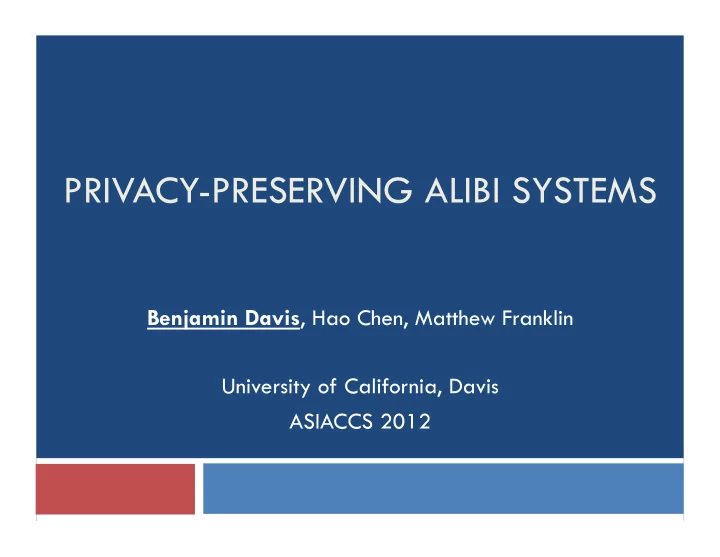

PRIVACY-PRESERVING ALIBI SYSTEMS Benjamin Davis , Hao Chen, Matthew Franklin University of California, Davis ASIACCS 2012
Motivation 2 “Murder Case Dropped After MetroCard Verifies Alibi” – New York Times, January 2009 Limitations of traditional alibis Not ubiquitous Can’t provide privacy
Motivation 3 Can we use our mobile devices to create alibis for us… without giving up our privacy? We can create alibis without revealing our identity Facilitate opportunistic alibi creation
Participants in an Alibi Scheme 4 Alibi Owner: “Olivia” Privacy always protected Alibi Corroborator: “Charlie” Identity may be public or private Judge:
Requirements for our Schemes 5 Privacy: owner identity hidden unless claimed No centralized or trusted third-party No storage burden on corroborators
Assumptions 6 Public Key Infrastructure Public/private keys for all owners, corroborators Devices with private keys are not shared ID of private key user == ID of private key owner ==
Alibi Creation 7 Two participants are in the same place
Alibi Creation 8 Owner records her identity and context Identity: “Olivia” Context: GPS, Date, Time
Alibi Creation 9 Owner sends sealed record to Corroborator
Alibi Creation 10 Corroborator certifies observation of record and context Context: GPS, Date, Time
Alibi Creation 11 Corroborator sends certification back to Owner Context: GPS, Date, Time
Alibi Storage 12 Owner stores “testimony” from corroborator Corroborator doesn’t store anything Context: GPS, Date, Time
Claiming an Alibi 13 Alibi owner sends testimony to Judge Context: GPS, Date, Time
Claiming an Alibi 14 Alibi owner links identity to record Context: GPS, Date, Time
Alibi Verification 15 Judge confirms Corroborator’s testimony matches owner’s claim and can be attributed to the corroborator Link between record and owner’s identity Identity: “Olivia” Context: GPS, Date, Time Context: GPS, Date, Time 15
Background: String Commitment Schemes 16 Cryptographic commitment schemes provide: Commit : commit to a value without revealing the value Decommit : reveal the committed value Our implementation uses [Halevi & Micali ‘96] Noninteractive Efficient computation and storage
Alibi Creation (public corroborator) 17 Owner Statement Owner Statement CORROB OWNER COMMITMENT TO { Corroborating Evidence Owner identity, Owner’s view of Context Owner’s signature } Corroborating OWNER JUDGE Evidence Owner Statement + Secret
Alibi Creation (public corroborator) 18 Corroborating Evidence Owner Statement CORROB OWNER { Corroborating Evidence Corroborator’s view of the Context, Corroborator’s signature over (OwnerStatement || Corroborator’s Context) Corroborating OWNER JUDGE Evidence } Owner Statement + Secret
Alibi Verification (public corroborator) 19 Owner presents: Owner Statement CORROB OWNER Corroborating Evidence Owner Statement Corroborating Evidence Decommitment for Owner Statement Corroborating OWNER JUDGE Evidence Owner Statement + Secret
Alibi Verification (public corroborator) 20 Judge checks: Owner Statement CORROB OWNER Corroborator’s signature Decommit Owner Statement Corroborating Evidence Owner’s signature Owner’s context matches Corroborator’s context Corroborating OWNER JUDGE Evidence Owner Statement + Secret
Security Against Malicious Alibi Owners 21 Alibi owner can’t modify context Alibi owner can’t transfer alibi Can’t reuse Corroborating Evidence
Security Against Malicious Alibi Corroborators 22 Identity of alibi owner is hidden until alibi is claimed Corroborator can’t reuse or fabricate Owner Statement
Private Corroborator Scheme 23 Limitations of Public Corroborator Scheme Corroborator must reveal identity during creation Naïve solutions to this problem Corroborator decides at creation time? usability nightmare Corroborator maintains state until owner claims alibi? misaligned incentives
Review: Public Corroborator Scheme 24 Owner Statement 1) Alibi Creation Owner learns corroborator’s identity CORROB OWNER Corroborating Evidence Corroborating 2) Alibi Verification OWNER JUDGE Evidence Owner Statement + Secret
Private Corroborator Scheme 25 Owner Statement CORROB 1) Alibi Creation OWNER Neither identity revealed Evidence Reminder Owner 2) Alibi Corroboration Statement + Secret CORROB OWNER Both must choose to Evidence Reminder participate Corroborating Evidence + Secret 3) Alibi Verification Corroborating OWNER JUDGE Same as public scheme Evidence Owner Statement + Secret
Private Corroborator Scheme 26 New requirement: anonymous messaging system* Only for message delivery, not our security/privacy properties Owner contacts corroborator to obtain corroboration before claiming an alibi * E.g. SMILE [Manweiler, Scudellari, Cox. CCS 2009]
Advantages over Traditional Alibis 27 Alibi owner’s consent required to Create alibi Reveal identity Alibis are unambiguous, nontransferrable Owner can’t fabricate corroboration without the corroborator’s participation Corroborator can’t fabricate an alibi without the owner’s participation
Limitations Shared with Traditional Alibis 28 Some forms of perjury Alibi owner and alibi corroborator collude Someone makes alibi on owner’s behalf (sharing of private key/device)
Conclusion 29 Privacy-preserving alibi systems Privacy not compromised when creating alibis Efficient design and implementation for mobile devices Fast, small for alibi owners Stateless for alibi corroborators
Recommend
More recommend